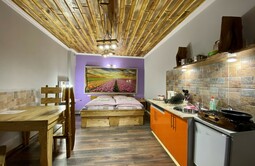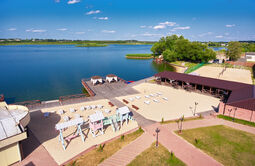The hillfort of Castle mountain in Braslav
Braslaw – Belarus city located in the Vitebsk region and has a rich historical heritage for which this region is so valued by the tourists coming on rest in Belarus.
The first mention of the city dates from about the year 1065. Then the settlement was called Bratislave in honor of Brjachislav Izyaslavich – Duke of Polotsk, who made settlement of the frontier. Today castle hill is the main historical and cultural monument in Braslav.
To visit the Braslav region through tours of Belarus or to the airport in his car.
The town of Braslav is a hill with a height of 14 metres with a flat top and steep slopes. Castle mountain is located between lake Drivyaty and Nowata, in the heart of the city.
From the history
The court settlement size 200*100 meters surrounded by ramparts, which sometimes reach a height of 4 meters, and the Western or North-Western part and 9 meters.
In the middle ages it housed a wooden castle. The first fortifications were erected in 8 – 9th centuries, when settlers leveled the top, poured shafts for defense, and built walls.
In the 11th century on the hill was built a powerful fortress. For an existing version of this happened during the reign of Prince Brjachislav Izyaslavich of (1003 – 1044.).
Later on the castle was mentioned in the beginning of the 16th century in 1514. Then he looked serious defensive structure, surrounded by strong walls. The castle had 7 towers, one of which had a very large width. It was the away tower with two iron gates and two loopholes.
On braslavska the settlement was initially populated by the Baltic tribe and Krivichi. Objects found here (rannelanda tableware, molded ceramics Krivichi, etc.) gave a vivid picture of life at that time.
In the cultural layer of the middle horizon, which from the 11th to mid – 13th century were found fragments of wooden buildings. In one of them there are remnants of the furnace. There were also found clay and slate whorls, sheath, bone combs, fishing tackle, battle axes, iron wrote, a powder flask made from horn and stone crosses.
Among the jewelry during the excavation revealed the following items: glass beads, bronze rings and bracelets, buckles and brooches, temporal rings, bracelets with snake-like ends.
The cultural layer of the upper horizon belongs to the 14 – 18th century. Here was discovered a metal pectoral cross, the Lithuanian coin of the 14th century, fragments spurs, arrowheads, knives, pottery, tiles, ornaments, locks and keys. All these findings suggests that the people who lived here were engaged in pottery, hunting, fishing, agriculture, weaving and blacksmithing.
At the end of the 10th century near the fortress began to appear town. The first houses appeared around the mountain. The heyday of the ancient Braslav fell on the 11 – 13th centuries when the city was actively engaged with the Polotsk and other cities and towns in the Eastern Baltic region and Kievan Rus.
Braslav's fortress was repeatedly attacked by Baltic tribes. From the 13th century it became the Central location for the garrison, civic center and residence administration.
In the early 14th century the surrounding area became part of the on and the city became the center of the district of the Vilna province. On the hill was located the courts, the archives and the administration of the district. This place held the diet for the gentry.
The intensive development of life on the mound ended in the 18th century. It was empty and fell into disrepair.
Mysteries and legends
Several legends associated with the ancient settlement. One of the major talks about how the name of Braslav.
Once in the castle there lived a Prince of Dvin, his wife named Troika and their daughter Drive. She was very proud and willful, svetalisa rejected all her suitors. At this time, the Prince of Dvin was beginning to wonder to whom he will give his possessions, and the daughter could not choose a favourite.
To Drive wooed three of the young Prince, three brothers – LIC, and New Bras. They were persistent, and Drive promised to give his heart to the one who can prove their superiority over rivals.
Bras showed themselves better than others in tests and his brothers decided to take revenge on him basely to kill. They waylaid him late one night and brutally murdered.
However Drive were willing to choose only the one most worthy. So the brothers decided to fight each other and both died from fatal injuries.
At dawn it became known that a New Snood and killed the wrong man. They mixed up a Brace with his servant, who in an unfortunate coincidence, wearing the cloak of the owner.
Bras came to the castle to Drive and blamed her for the death of his brothers. Proud Princess could not withstand such words and jumped into the water from a high tower.
Poor parents are unable to endure such grief. Brice was invited to take the place of the former ruler. He had a long and fairly, but never found the companion.
Over time around the castle formed a town, which was named in his honor – Braslav. Today, near the Castle hill there is a lake Drivyaty and the river flows Troika.
Castle mountain in our days
At the ancient settlement is now no settlements and no settlements of the ruins of the castle, but within the framework of the state program from 2012 to 2018 is the restoration of fragments of the castle.
Castle hill is a prominent monument of history and archeology, which is included in tours in Belarus. Nearby is the lake Drivyaty, a children's sanatorium camp "Braslav lakes".
Castle hill is often visited by tourists who stopped for a rest in Belarus in one of the many estates nearby.














